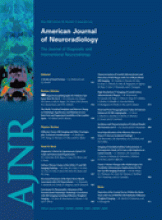Research ArticleNeurointervention
3D Rotational Angiography: The New Gold Standard in the Detection of Additional Intracranial Aneurysms
W.J. van Rooij, M.E. Sprengers, A.N. de Gast, J.P.P. Peluso and M. Sluzewski
American Journal of Neuroradiology May 2008, 29 (5) 976-979; DOI: https://doi.org/10.3174/ajnr.A0964
W.J. van Rooij
M.E. Sprengers
A.N. de Gast
J.P.P. Peluso

References
- ↵Kouskouras C, Charitanti A, Giavroglou C, et al. Intracranial aneurysms: evaluation using CTA and MRA—correlation with DSA and intraoperative findings. Neuroradiology 2004;46:842–50
- Yoon DY, Lim KJ, Choi CS, et al. Detection and characterization of intracranial aneurysms with 16-channel multi-detector row CT angiography: a prospective comparison of volume-rendered images and digital subtraction angiography. AJNR Am J Neuroradiol 2007;28:60–67
- ↵Jayaraman MV, Mayo-Smith WW, Tung GA, et al. Detection of intracranial aneurysms: multi-detector row CT angiography compared with DSA. Radiology 2004;230:510–18
- ↵
- ↵
- ↵Yaşargil MG. Microneurosurgery. Vol. 1. Stuttgart, Germany: Georg Thieme Verlag;1984 :301–03
- ↵Wermer MJ, van der Schaaf IC, Algra A, et al. Risk of rupture of unruptured intracranial aneurysms in relation to patient and aneurysm characteristics: an updated meta-analysis. Stroke 2007;38:1404–10
- ↵Kaminogo M, Yonekura M, Shibata S. Incidence and outcome of multiple intracranial aneurysms in a defined population. Stroke 2003;34:16–21
- ↵Juvela S. Risk factors for multiple intracranial aneurysms. Stroke 2000;31:392–97
- ↵Anxionnat R, Bracard S, Ducrocq X, et al. Intracranial aneurysms: clinical value of 3D digital subtraction angiography in the therapeutic decision and endovascular treatment. Radiology 2001;218:799–808
- ↵Tanoue S, Kiyosue H, Kenai H, et al. Three-dimensional reconstructed images after rotational angiography in the evaluation of intracranial aneurysms: surgical correlation. Neurosurgery 2000;47:866–71
- Sugahara T, Korogi Y, Nakashima K, et al. Comparison of 2D and 3D digital subtraction angiography in evaluation of intracranial aneurysms. AJNR Am J Neuroradiol 2002;23:1545–52
- Hochmuth A, Spetzger U, Schumacher M. Comparison of three-dimensional rotational angiography with digital subtraction angiography in the assessment of ruptured cerebral aneurysms. AJNR Am J Neuroradiol 2002;23:1199–205
- ↵
- ↵de Gast AN, van Rooij WJ, Sluzewski M. Fenestrations of the anterior communicating artery: incidence on 3D angiography and relation with aneurysms. AJNR Am J Neuroradiol 2008;29:296–8. Epub 2007 Nov 16
In this issue
Advertisement
W.J. van Rooij, M.E. Sprengers, A.N. de Gast, J.P.P. Peluso, M. Sluzewski
3D Rotational Angiography: The New Gold Standard in the Detection of Additional Intracranial Aneurysms
American Journal of Neuroradiology May 2008, 29 (5) 976-979; DOI: 10.3174/ajnr.A0964
0 Responses
Jump to section
Related Articles
- No related articles found.
Cited By...
- Acceleration of Brain TOF-MRA with Compressed Sensitivity Encoding: A Multicenter Clinical Study
- Plaque morphology in acute symptomatic intracranial atherosclerotic disease
- Current Hospital Demographics of Subarachnoid Hemorrhage Based on CT Angiography and 3D Rotational Angiography in a Neurosurgical Center
- Surveillance of Unruptured Intracranial Saccular Aneurysms Using Noncontrast 3D-Black-Blood MRI: Comparison of 3D-TOF and Contrast-Enhanced MRA with 3D-DSA
- Morphologic Change of Flow-Related Aneurysms in Brain Arteriovenous Malformations after Stereotactic Radiosurgery
- Morphologic Change of Flow-Related Aneurysms in Brain Arteriovenous Malformations after Stereotactic Radiosurgery
- Retrograde 3D rotational venography (3DRV) for venous sinus stent placement in idiopathic intracranial hypertension
- Yield of Repeat 3D Angiography in Patients with Aneurysmal-Type Subarachnoid Hemorrhage
- Two-color 3D-3D fusion of selective rotational cerebral angiograms: a novel approach to imaging in cerebrovascular neurosurgery
- Hemodynamic Differences in Intracranial Aneurysms before and after Rupture
- Guidelines for the Management of Patients With Unruptured Intracranial Aneurysms: A Guideline for Healthcare Professionals From the American Heart Association/American Stroke Association
- Diagnostic quality and accuracy of low dose 3D-DSA protocols in the evaluation of intracranial aneurysms
- Use of Follow-Up Imaging in Isolated Perimesencephalic Subarachnoid Hemorrhage: A Meta-Analysis
- Cost-Effectiveness of Angiographic Imaging in Isolated Perimesencephalic Subarachnoid Hemorrhage
- Reducing radiation dose while maintaining diagnostic image quality of cerebral three-dimensional digital subtraction angiography: an in vivo study in swine
- Diagnosing Intracranial Aneurysms With MR Angiography: Systematic Review and Meta-Analysis
- Flat Panel Catheter Angiotomography of the Spinal Venous System: An Enhanced Venous Phase for Spinal Digital Subtraction Angiography
- Contrast-free MRA at 3.0 T for the detection of intracranial aneurysms
- Patient-Specific Computational Hemodynamics of Intracranial Aneurysms from 3D Rotational Angiography and CT Angiography: An In Vivo Reproducibility Study
- Utility of CT Angiography in the Identification and Characterization of Supraclinoid Internal Carotid Artery Blister Aneurysms
- Opinion: Imaging Follow-Up after Coiling of Intracranial Aneurysms
- Large-Cohort Comparison Between Three-Dimensional Time-of-Flight Magnetic Resonance and Rotational Digital Subtraction Angiographies in Intracranial Aneurysm Detection
- Comparison of 2D Digital Subtraction Angiography and 3D Rotational Angiography in the Evaluation of Dome-to-Neck Ratio
- MR Angiography Follow-Up 5 Years after Coiling: Frequency of New Aneurysms and Enlargement of Untreated Aneurysms
- Coil Embolization of Very Small (2 mm or Smaller) Berry Aneurysms: Feasibility and Technical Issues
This article has not yet been cited by articles in journals that are participating in Crossref Cited-by Linking.
More in this TOC Section
Similar Articles
Advertisement











